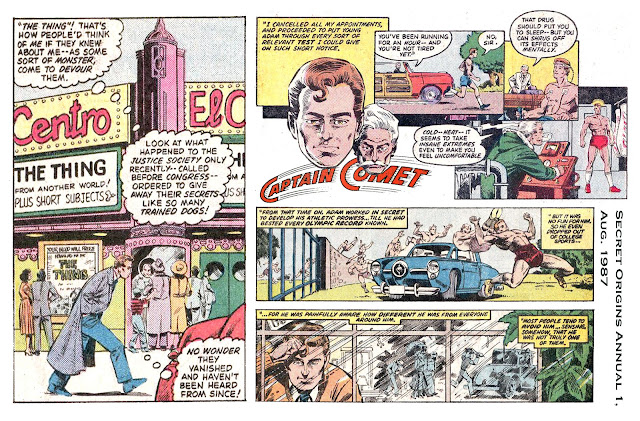May 1953: The Father of Grodd
DC Comics’ Strange Adventures might be called the predawn of the Silver Age.
For example, in
several ways, Strange Adventures 32
(May 1953) prefigures the revamped revival of the Flash three years later. And
Captain Comet, the title’s lead feature, is clearly a forerunner for the
streamlined jet-age superheroes to come.
At the end of his previous
adventure, librarian Lily Torrence, seeing Captain Comet for the first
time on television, had remarked to Adam Blake that they look awfully similar.
Blake tries to cover up in that feeble Clark Kent manner — “Oh, it’s, er, just
your imagination, Miss Torrence!”
But he needn’t have bothered,
since by the next issue he has apparently forgotten he has a secret identity.
In Strange Adventures 32, Murphy Anderson’s art shows us Captain Comet
at the front door of Blake’s house, receiving a telegram sent to him by a
scientist in Africa. The Western Union deliveryman is impressed that Comet
clairvoyantly knows whom the message is from before opening it.
Given his psychic super powers, you
sort of wonder why he needed to open it at all.
In any case, in The Challenge of Man-Ape the Mighty!, the
Cometeer is soon speeding toward
Africa, where Comet’s friend Prof. Sarcon had been running down reports of a
super-evolved tribe of gorillas.
Yes, this writer, John Broome,
would recycle both concepts as the hidden African Gorilla City and the Flash’s
archenemy Grodd.
Finding Sarcon paralyzed by
Man-Ape’s telepathic hypnosis, Comet is kayoed. He awakens to find that Man-Ape
had forced Sarcon to exchange his simian form for Captain Comet’s mutant
super-body, and then promptly shot Sacron dead.
Trapped in the body of an ape,
unable to speak, Comet makes his way back to the U.S. as a stowaway and, rather
unconvincingly, tricks Man-Ape into switching bodies again.
Ironically, while the Silver Age Flash
was anticipated in this issue, the Golden Age Flash was already being ignored,
even though he’d bowed out only two years before in All-Star Comics 57 (Feb.-March 1951).
In the Sid Gerson/Howard Sherman
story The Human Bullet, we find a
darker version of Jay Garrick’s origin. When biochemist Dr. Saunders concocts a
super-scientific drug that will increase human speed a thousand times,
unscrupulous college athlete John Stoll arranges to secure it for himself.
Stoll wins football games, prize
fights and even horse races, killing a gambling czar who tries to rob him by
catching and hurling his own bullet back at him.
Running low on wonder pills, Stoll
snatches a fresh supply from Dr. Saunders’ desk, but the biochemist outwits him
by planting bicarbonate tablets there instead.
While running on water like the Flash, Stoll sinks when the
drug wears off. And because he can’t swim, that disposes of the problem.
Another “strange” adventure about
a super-speedster who came to a bad end would appear six years later in Strange Tales 67, in the Jack Kirby
story I Was the Invisible Man!





Broome may have been inspired by Stanton A. Coblentz’s short story Titan, published seven years earlier in the Thrilling Wonder Stories pulp.
ReplyDeleteIn that story, a super-intelligent African gorilla named Titan has caged the scientist who’d tested a “Fluid of Enlightenment” on him. Humans and animals wage a war, deploying as weapons that substance and a “Depression Fluid” that represses intelligence, with the humans barely winning.
Before he is devolved, Titan likes to wear a “crownless straw hat perched crookedly over his head (giving) him a rakish appearance.”
Joseph Lenius:
ReplyDeleteDan Hagen, did you ever send a letter to DC, thanking them for being abject morons for canceling the Captain Comet Archives the idiots had solicited?